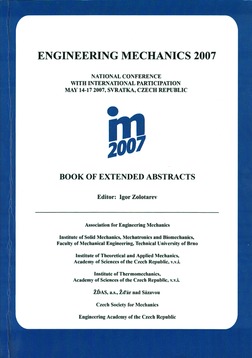Proceedings Vol. 13 (2007)

ENGINEERING MECHANICS 2007
May 14 – 17, 2007, Svratka, Czech Republic
Copyright © 2007 Institute of Thermomechanics, Academy of Sciences of the Czech Republic, v.v.i., Prague
ISSN 1805-8248 (printed)
ISSN 1805-8256 (electronic)
list of papers scientific commitee
pages 225 - +8p., full text
The aim of this contribution is to investigate aggregation efficiencies when high (G= 260 s-1) and low (G= 60 s-1) intensity agitation is applied for a treatment of surface water with high content of humic substances in a pilot size operation. It was established that high intensity agitation represented by a fluid layer of granular material (FLGM) can be more effective for an aggregation agitation than low intensity agitation with the help of the perforated baffles (PB). The FLGM improves performance of the filters because the filtration runs in the technological arrangement with FLGM took longer periods compared with low intensity agitation. Introduction The aggregation agitation influences the properties of aggregates being formed which, in turn, decisively influence their separation capabilities. In water treatment technology the movement of liquid is caused by agitation either by hydraulic or mechanical means at which the aggregating particles are subjected to the action of adhesive forces (affecting their combining) and tangential, shear forces (preventing their combining). Mutual ratio of the magnitudes of these forces is a factor determining kinetics of the aggregation process. In addition, it also influences resultant size and inner structure of the aggregates formed, i.e. the properties of aggregates that are important from their separation point of view. Generally, the influence of mutual ratio of the two forces on the structure of aggregates formed can be described as follows: when the colliding particles affect one another by great adhesion forces and when the tangential forces are small, then the particles join one another at the point of their first contact. As a result, sizeable voluminous aggregates of a geometrically loose, widely branched spaciously extended net structure are formed. Such aggregates contain large quantities of voids that are filled with entrapped water. The ultimate aggregates are large, having low density and are very fragile with a tendency to fragment. In contrast, when the colliding particle affect one another by small adhesion forces and tangential forces are great bit smaller than the critical ones, the colliding particles during their combining slide along each other until they occupy geometrically the most favourable and energetically the most stable position. As a result smaller aggregates of a compact and relatively arranged structure, more resistant to fragmentation are formed. Such aggregates have a smaller volume of voids and hence contain a smaller volume of entrapped water. Consequently, their density is higher. Similar situation occurs when the colliding particles are affected by great adhesion forces and exposed to action of great tangential forces because great tangential forces weaken the effect of great adhesive forces. When the tangential forces affecting the colliding particles are considerably greater than the adhesive forces, the aggregation of particles does not occur or occurs to a very limited extent only.
back to list of papers
Text and facts may be copied and used freely, but credit should be given to these Proceedings.
All papers were reviewed by members of the scientific committee.

 Powered by
Imce 3.20 © 2023, Pavel Formánek, Institute of Thermomechanics AS CR, v.v.i. [generated: 0.0106s]
Powered by
Imce 3.20 © 2023, Pavel Formánek, Institute of Thermomechanics AS CR, v.v.i. [generated: 0.0106s]